When i sat down to watch “Unstoppable“, the new movie by Tony Scott featuring Denzel Washington, Chris Pine and Rosario Dawson, i was immediately drawn into the heavy industrial visual atmosphere of the movie. The opening sequence delves into what looks like a blue collar neighbourhood, with dominating turquoise color and a few splashes of yellows and browns:

When the two leading characters are introduced, the color palette becomes a little richer with tinges of green, still remaining in the predominantly cool and desaturated band:

The vast majority of outside sequences feature railroads and trains – static at the beginning as shown in the next image. Note the color variation between the different models, balanced by the consistent pinstripe pattern that brings yellows and oranges into the scene saturated with blues, turquoises and greens of the trains and surrounding forest:
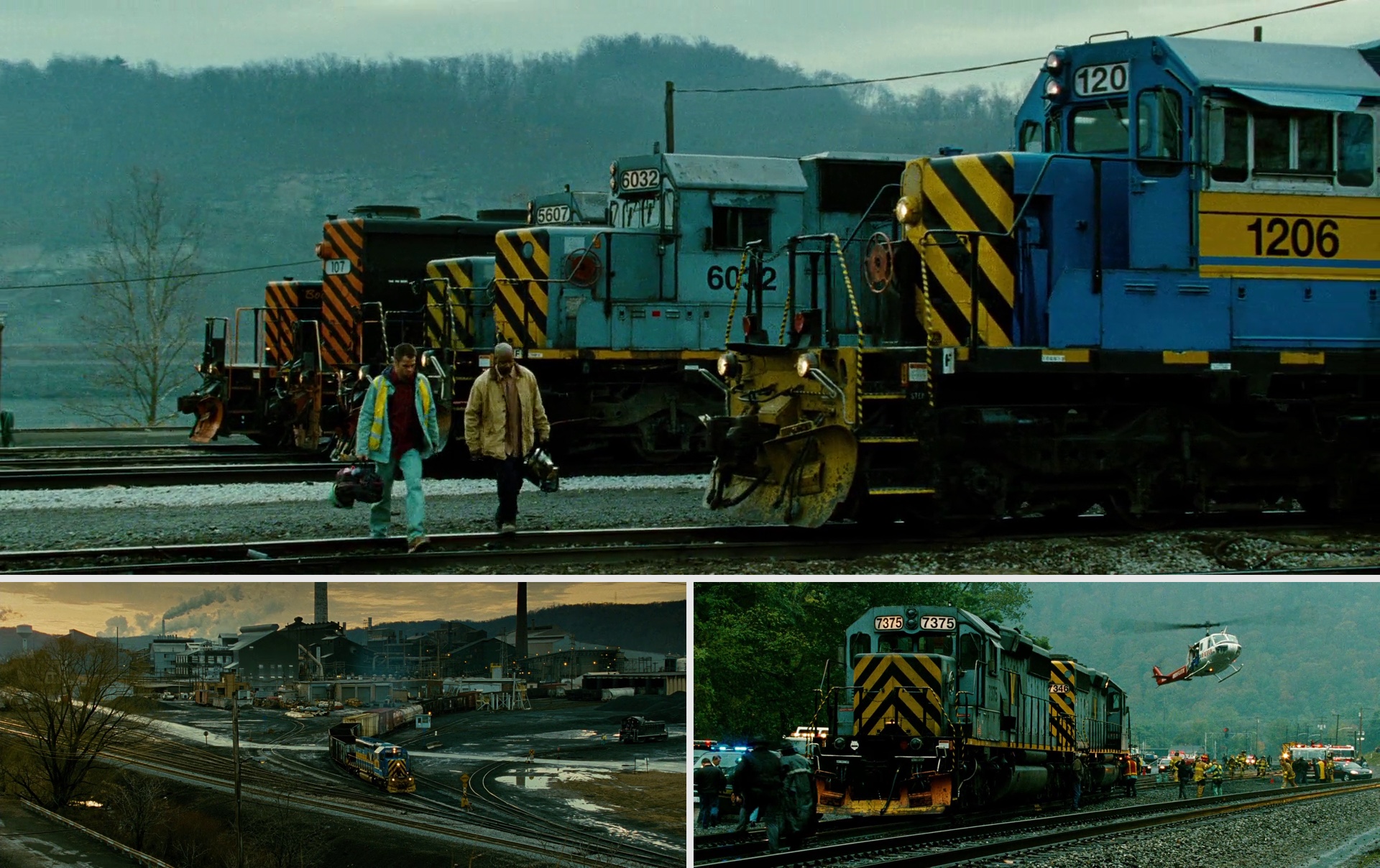
Once the characters get on the train, the camera switches between inside and outside shots, rarely placing the two together in the same frame. The outside shots are taken close to the cabin windows, with blurry rain drops creating attractive secondary textures that blend well with the carefully crafted interior design:

Once the train gets moving, it provides a fast changing dynamic scene. The third lead character played by Rosario Dawson is placed into a control room, leaving her to rely on radio communication and telemetry systems to collect information. Here is her character on the backdrop of an oversized route map. The map uses a variation of each primary color – red, blue and green, all shifted and desaturated to serve as a supporting visual element:
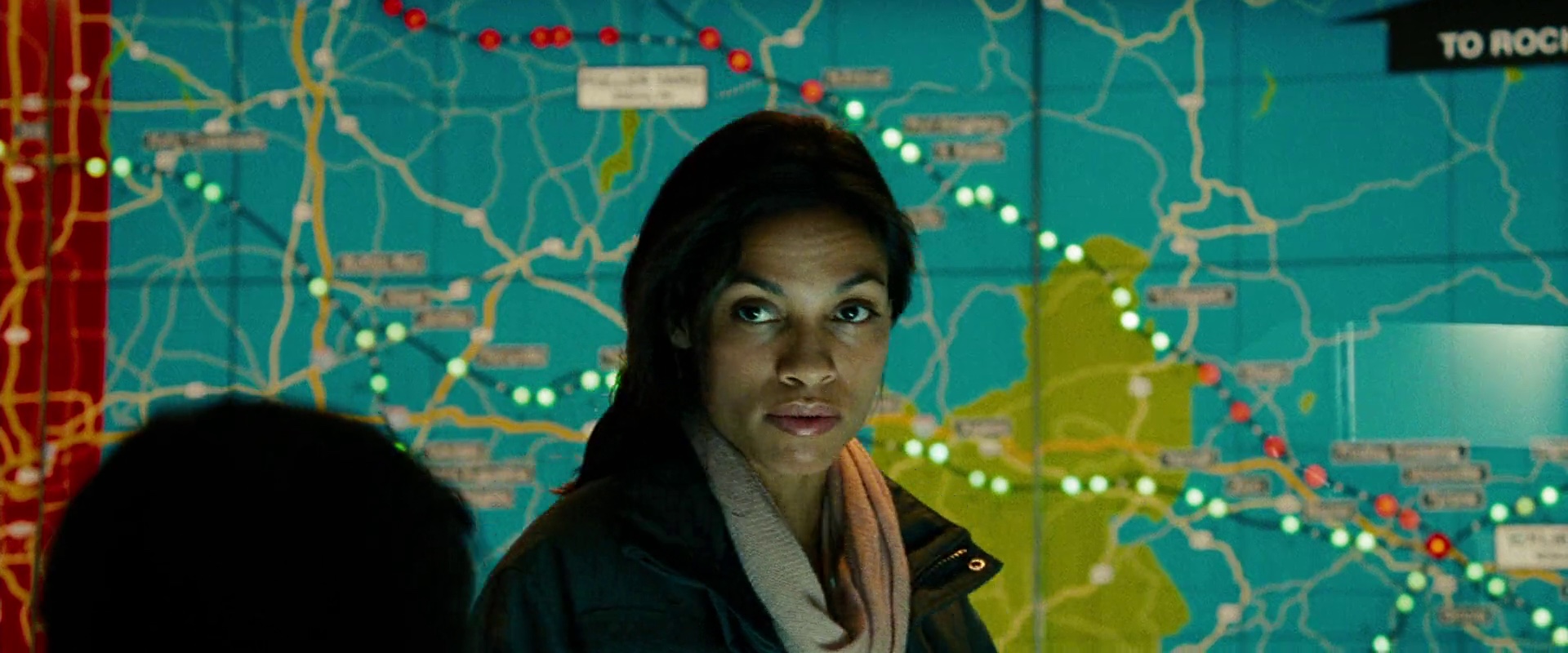
While most of the scenes in the control room are dominated by close-up shots of Rosario, the camera switches to the supporting characters to add some depth and variety. These characters are often filmed from a greater distance that highlights their secondary role and adds more perceived space to the location itself. Here, note the multitude of screens, each deriving from the main color palette of sand yellow, olive green, turquoise and brick red:

Extending the through-the-glass shots mentioned above, the camera moves quite freely around the control room, crossing boundaries of the rooms, open spaces and glass cubes. Not only this adds a lot of dynamism to this closed environment, it also places the viewer as an outside observer in a setting not accessible to general public. The next image illustrates this perfectly – the glass wall extends two thirds into the frame, adding an element of “observing with being noticed” – with the slightly blurred texts further highlighting the access restrictions:

The tension around the runaway train is further reinforced by cutting to live TV feed from a local station. For an extra dramatic effect, this starts early on and is weaved into the interaction between three main characters. Most TV scenes are live-“shot” from the helicopters, adding large swaths of rich green forestry. This is balanced by the oranges, yellows and turquoises taken from the engine yard and control room monitors – further anchoring the cool color palette of the entire movie:
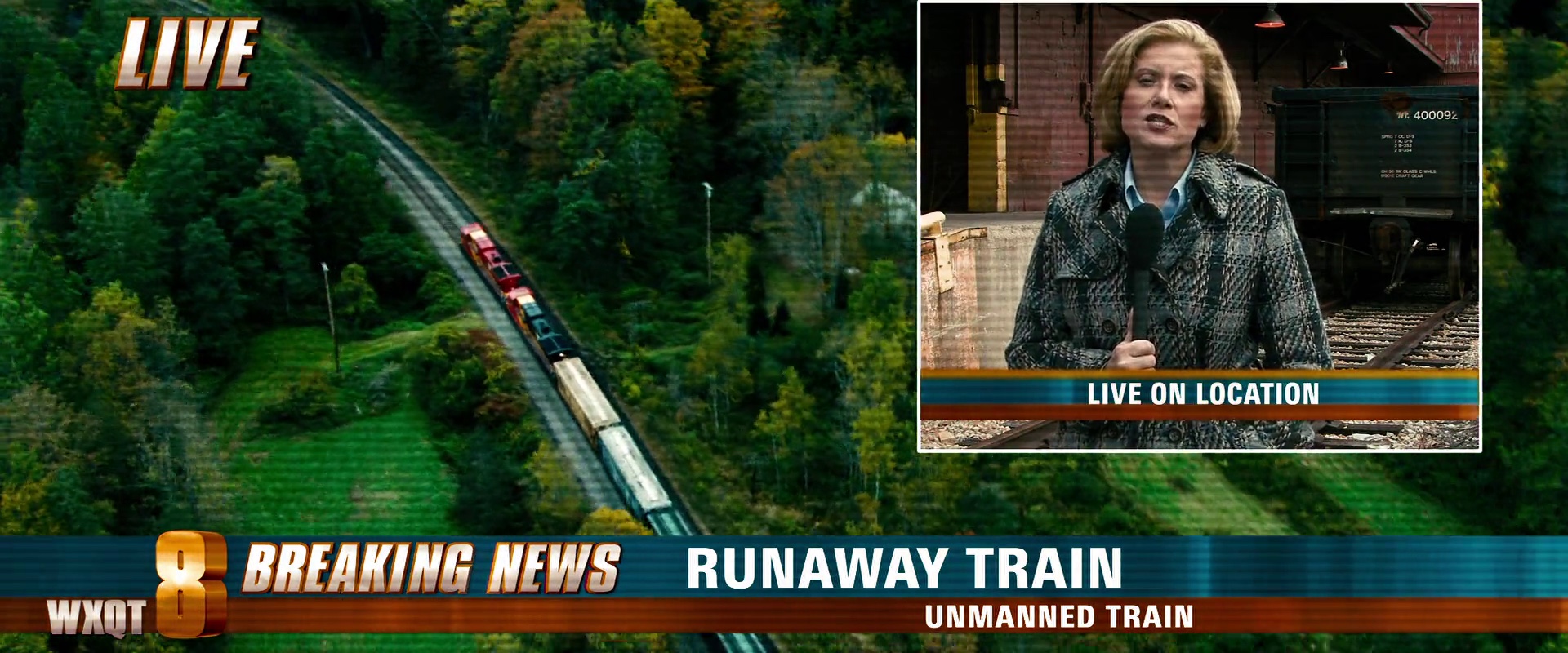
Some shots feature close ups of the locomotive. Bright oranges and reds of the exterior paint are supported by the emergency vehicles, patrol helicopters and police car flash lights. The next image shows a scene as filmed by the low-flying TV station helicopter. The camera is pointing forward, and rain drops add extra authenticity to the view, creating large blurred spots and causing nice refraction halos:
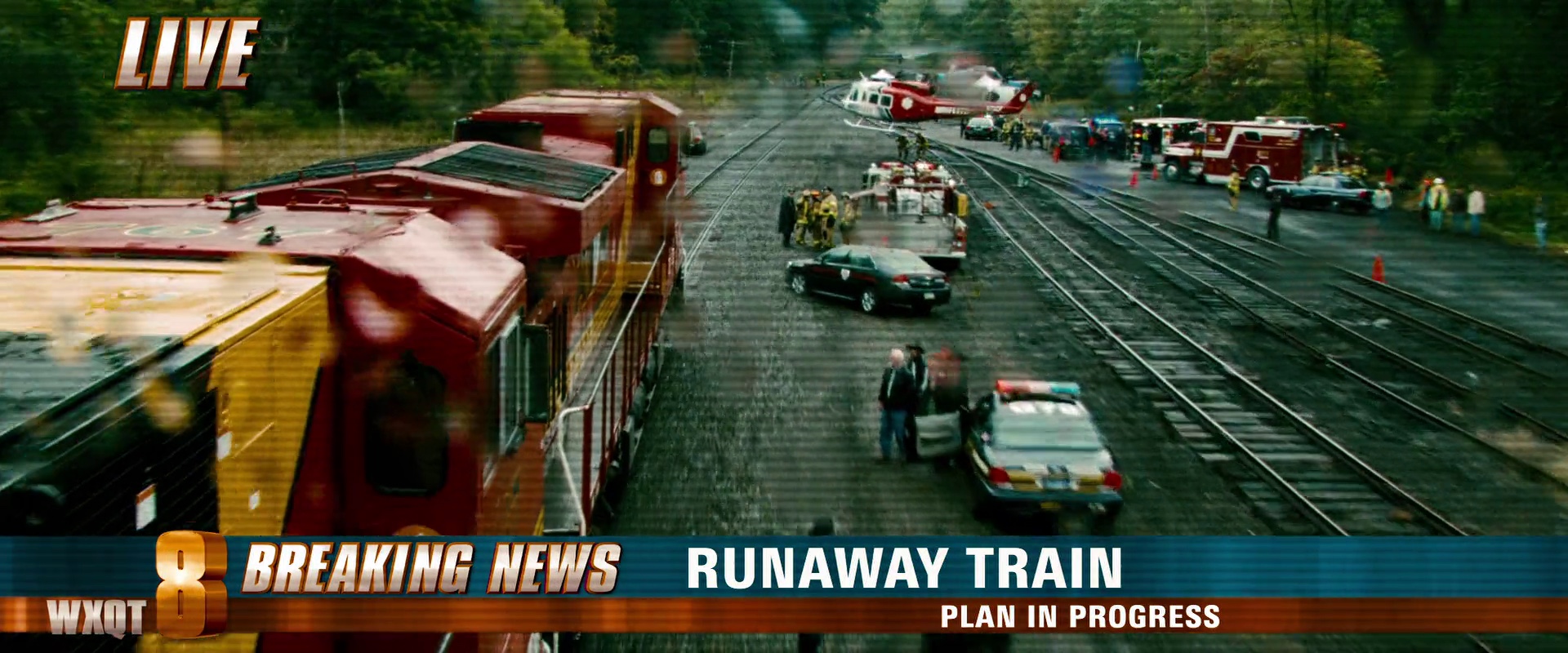
As the TV cameras follow the train along its winding path, the aerial shots are intertwined with stationary cameras – highlighting the opportunity that the ground crews had to mobilize the large vans. As before, such images frame the moving trains with lush forest scenery and standby emergency crews – note the red and yellows of the locomotive match the colors of the firefighter uniforms:

And yet one more example of a complex scene that combines two overlapping feeds. The oranges, yellows and turquoises of the TV station identity define the visuals of the feeds as well – note the sand yellow hair color of the reporter, combined with her light blue blouse and a glimpse of the roof flash lights on the police car behind her:
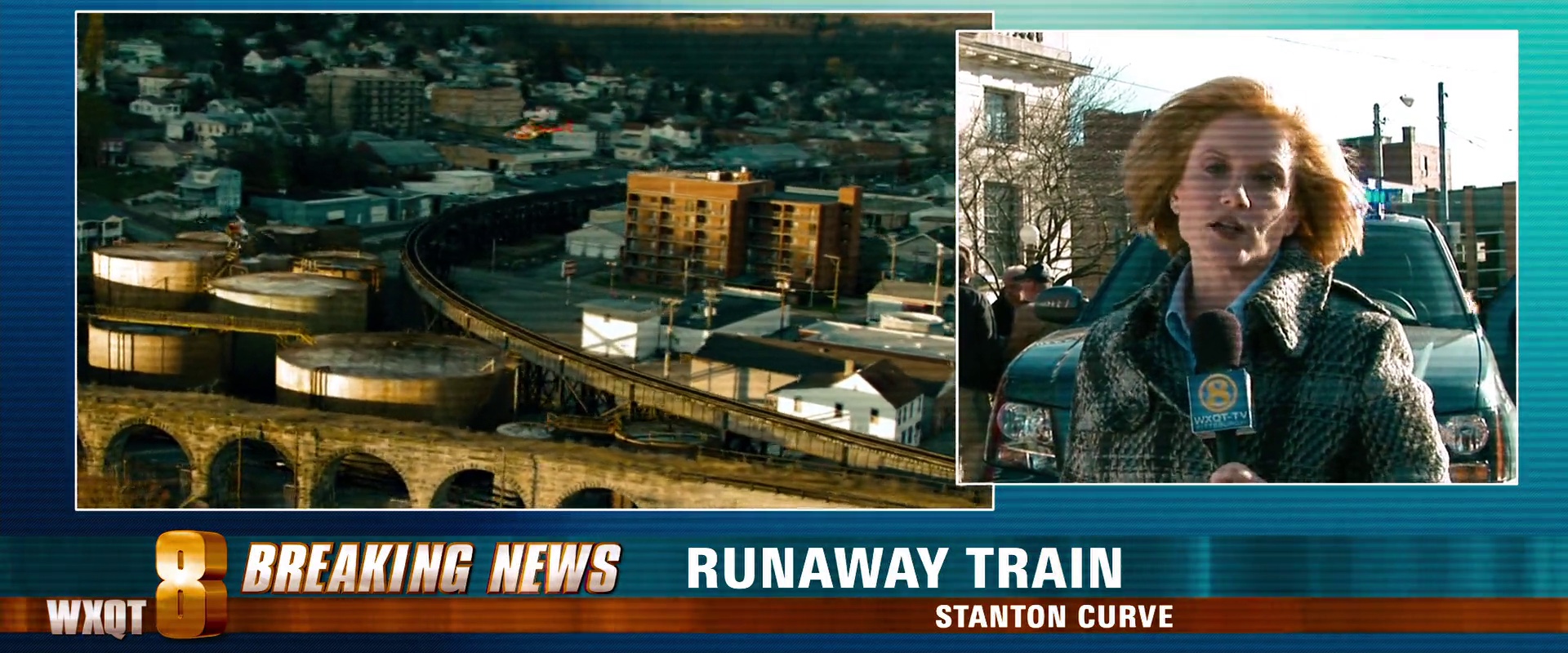
And this is, perhaps, my favorite shot:
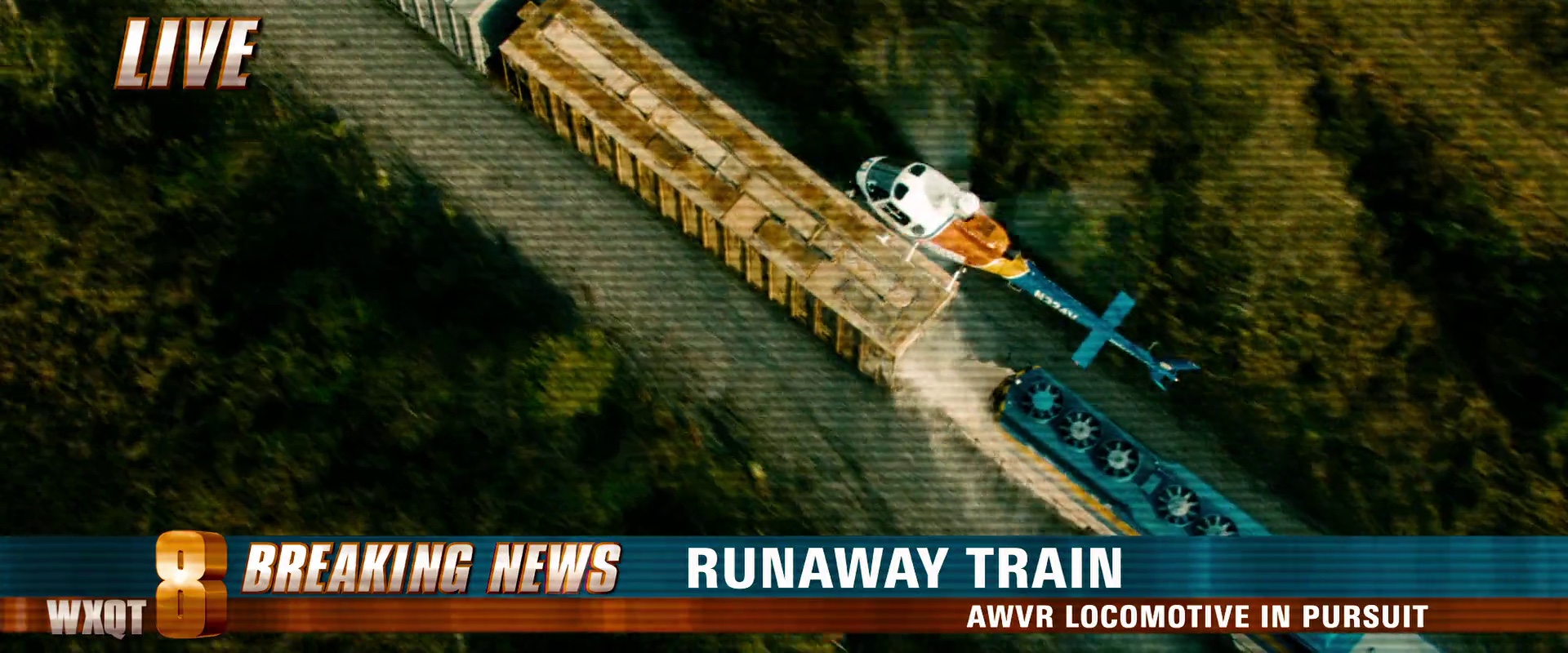
There are three main elements here, all “moving” in a perfect visual unison. The news strip at the bottom, the train cars and the hovering helicopter all use the same color transitions – deep turquoise on the right and yellow orange on the left. This is a very strong palette that serves as a major backbone for the entire movie.
It is my absolute delight that Drew Boughton, one of the key people responsible for the movie visuals has agreed to answer a few questions about his work on the movie and the industry in general.
 Kirill: Tell us a little bit about yourself.
Kirill: Tell us a little bit about yourself.
Drew: My name is Drew Boughton. I am a Production Designer and live in Los Angeles with my wife Linda Boughton who is a Fine Art Painter.
Kirill: Production designer, art director, set director – all sound vaguely the same for people not closely involved with the industry. Can you explain the creative process behind the movie visuals?
Drew: Yes, a Production Designer is the key visual collaborator on the look of the movie working with the director prior to the involvement of the DP or Director of Photography. On “Unstoppable” the Production Designer was Chris Seagers. The Production designer is responsible for everything that is “seen” on camera. The selection of locations, colors and feel are all shepherded by the production designer in the prep process of the movie. The Director approves or makes changes as he or she sees fit.
The Art Director is the person who implements the design of the movie. This is done through directing and supervising the creation of drawings, the organizing of construction, paint and set decorating crews. This is generally speaking a “hands on” artistic job. I was one of three Art Directors on the film. Dawn Swiderski and Julian Ashby shared that title and responsibility with me.
Kirill: Looking at your career as an art director, you do roughly one movie a year over the last ten years. Would it be correct to say that your part starts long before the actual filming and ends long after the actors have moved on to their next movie?
Drew: My job starts 3-4 months before filming begins. And generally ends after all principal photography is done.
Kirill: The full crew page for “Unstoppable” lists well over a hundred creative artists in the art and visual effects departments – and you have even more for the upcoming “Pirates of the Carribean”. How do you make sure that the end product has a consistent look that supports the main storyline, and stays “out of the way” as much as possible?
Drew: There are a lot of people involved in managing that including the producers and the DOP (director of photography) who is principally in charge of capturing everything on film in a graceful and beautiful way that is consistent with the storyline etc. Of course the real person who guides all of this is the Director whose vision is being served by all the people around them.
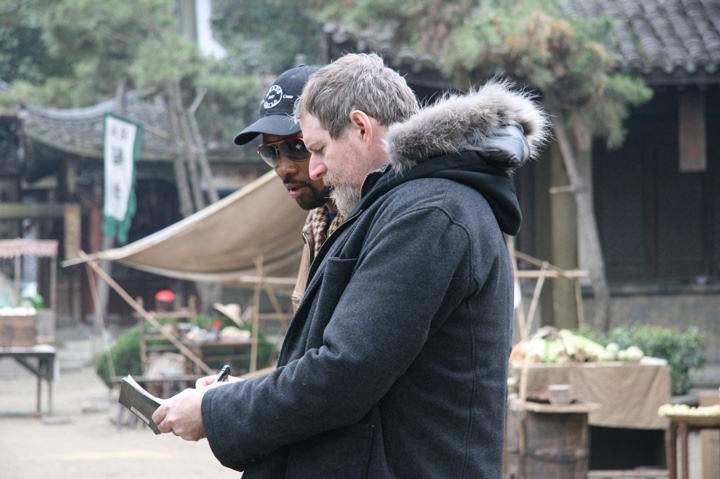
Drew and RZA on the set of the upcoming “The Man with the Iron Fists” movie that stars Russell Crowe, Lucy Liu and Pam Grier.
Kirill: What is your ideal level of movie director’s involvement with the art department? Do you prefer getting a high-level description of the visual mood and a cart blanche control over the entire set, or perhaps a closer collaboration throughout the various production stages?
Drew: The ideal level depends really on the Director. It is not so much a matter of preference. The thing is that an Art Department is a service based thing. We offer a specific service to the Director of a film. If that Director wants to be involved in reviewing every sketch or drawing the Art Department makes that is great with me. If the Director does not want to be “bothered” with seeing every drawing that is cool too. Although it can make for surprises on set which sometimes are a little uncomfortable. It just depends on the person.
Kirill: Most of the outside scenes in the movie feature heavily tinted turquoise palette. How much of this was done with lens filters, and how much was left to the post-production stage?
Drew: Tony Scott is widely respected (and emulated) in the Film industry for his unique photographic look. His films are considered masterpieces of cinematography and he has the experince to choose certain types of cameras and equipment with a desired look in mind before the film is ever produced. Most of the color comes from that knowledge of photography and a final “tweak” comes in post production digitally
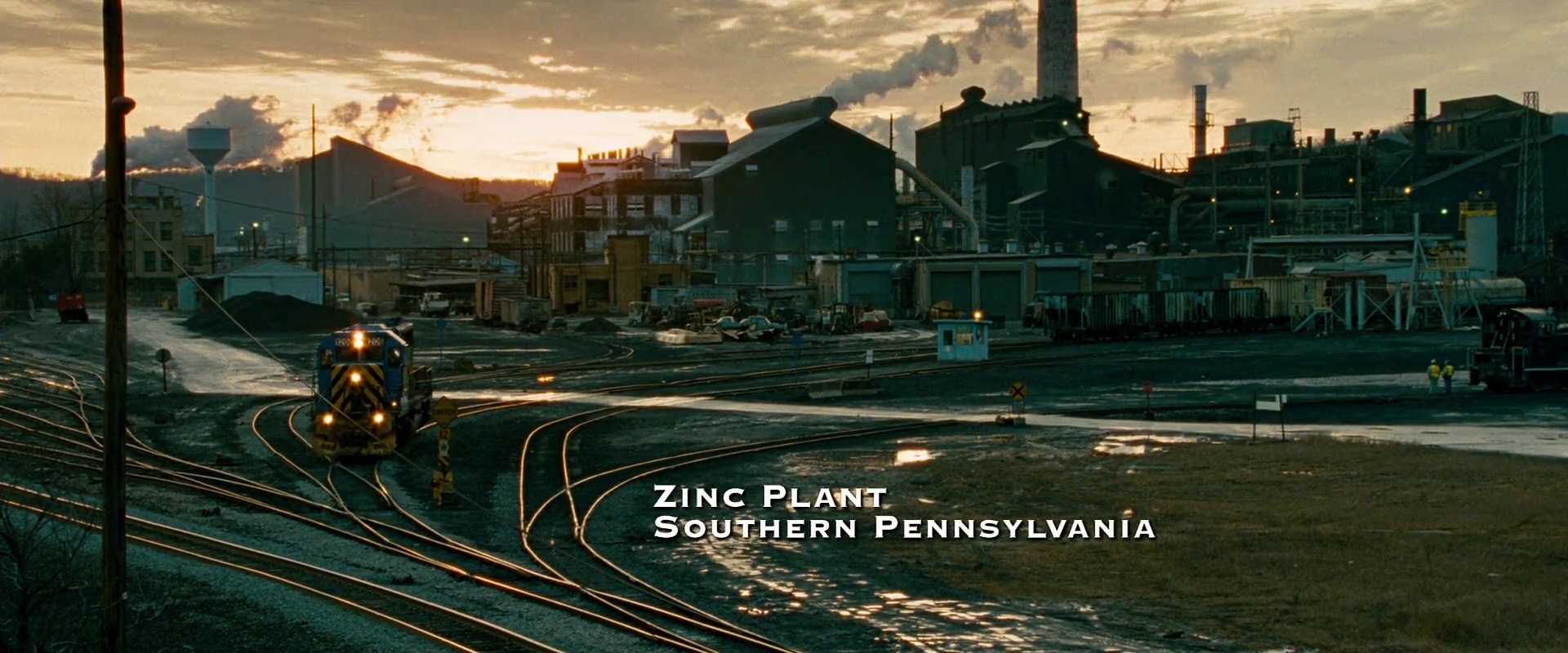
Kirill: A lot of outside scenes were shot on rail yards and bridges. How much control over the production design of such scenes are you willing to cede to external parties?
Drew: We shot in existing locations primarilly which were stunning. So we have to give it for those cool places. The things we brought to the locations were all of our trains which were painted by us. We painted all the pricipal locomotives and train cars specifically to the instructions of Director Tony Scott and Production Designer Chris Seagers. As you watch the movie much of what you see is the trains themselves.
Kirill: The main control room (where Rosario Dawson spends the majority of the movie) is my favorite location. How much work goes into creating such a detailed indoors environment?
Drew: A tremendous amount went into that. That was a built set on stage in Pittsburgh. The giant illuminated map was created from scratch and animated to assist in telling the story.
Kirill: The transition from black-and-white movie to full color ones midway through the 20th century took a few good decades. Are we witnessing the beginning of a similarly lengthy and inexorable transition to productions that are not only augmented, but also predominantly produced in virtual CGI / VFX environments?
Drew: I don’t know of anyone on the planent who could honestly answer that question. The thing is do you want to watch a real Actor acting? If you do it will be hard to replace that person with a 3D model. As for the enviornments it is a bit of the same question: real actors in fake environments are “fake” to me personally so I tend not to like those movies.
Kirill: On a related note. The last two Oscar awards for art direction went to “Avatar” and “Alice in Wonderland” – both blurring the lines between real and imaginary worlds, fusing real actors and computer-generated characters in lush otherworldly environments generated on massive render farms. Do you see this as a passing fad that is “rewarding” the technical advancements, or a more steady trend away from traditional production and art design?
Drew: I think that both of those films are excellent and both feature traditional Production Design. The distinction is the implementation of the design. Sometimes is constructed in real space as the Avatar lab was and sometimes it is in 3D depending on the practical needs of the script.
I do not see any steady trend one way or the other. I see improvements in technology that film makers use to tell a story. To me it is more a question of what story the film maker wants to tell. If it is more films about future science fiction worlds than thats one answer. But sometimes a film maker wants to heave real drama based in real places as “Unstoppable” was. These were real trains with real stunts and very minor VFX augmentation. Which is why it is so gripping.
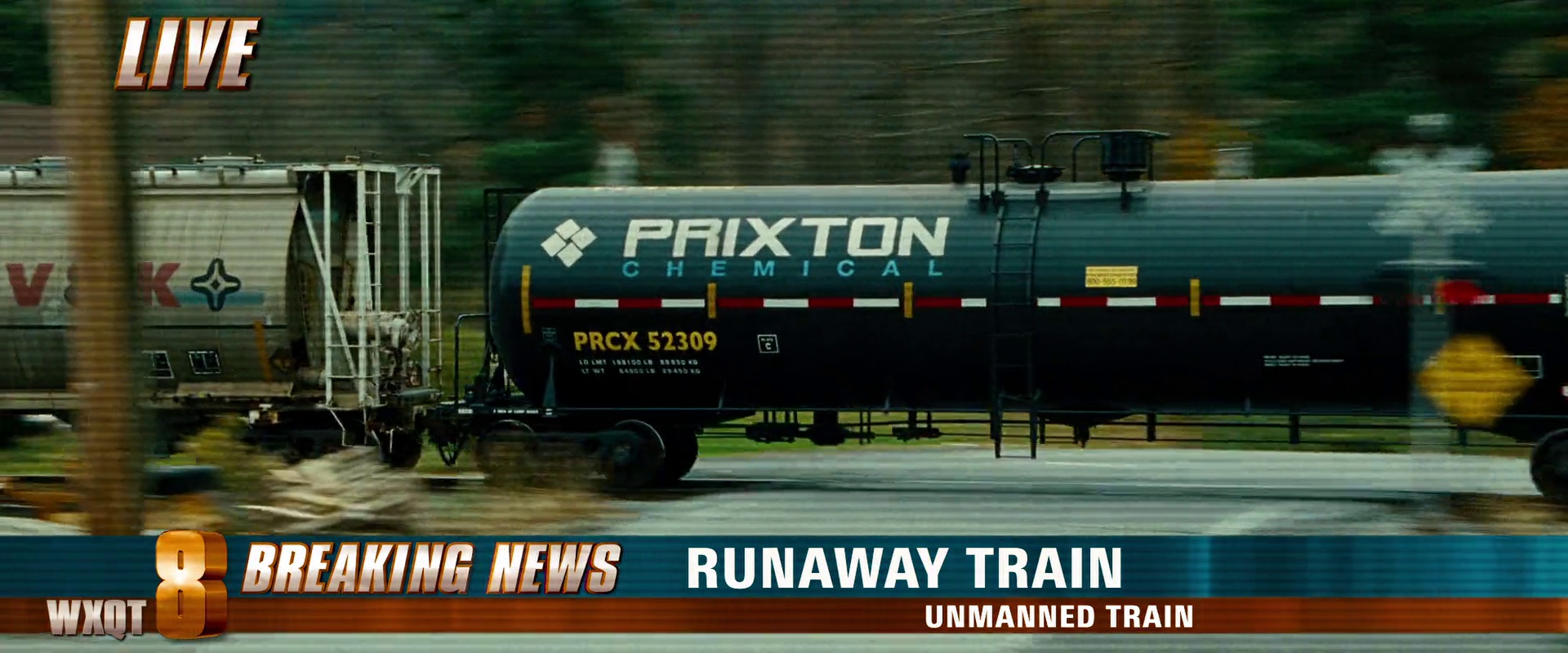
And here I would like to thank Drew Boughton once again for this wonderful opportunity, and his great work on the movie. I want to leave you with two more images. The one above is another shot from the TV feed – note how the train movement is conveyed by blurring the surrounding scenery while still keeping the cargo details in focus. And, if you haven’t noticed up until now, look at the translucent horizontal stripes applied on all TV scenes, helping to separate them from the rest of the sequences.
And here is the beautiful Rosario Dawson framed by the blurred wall monitor and muted steel blues and greens:
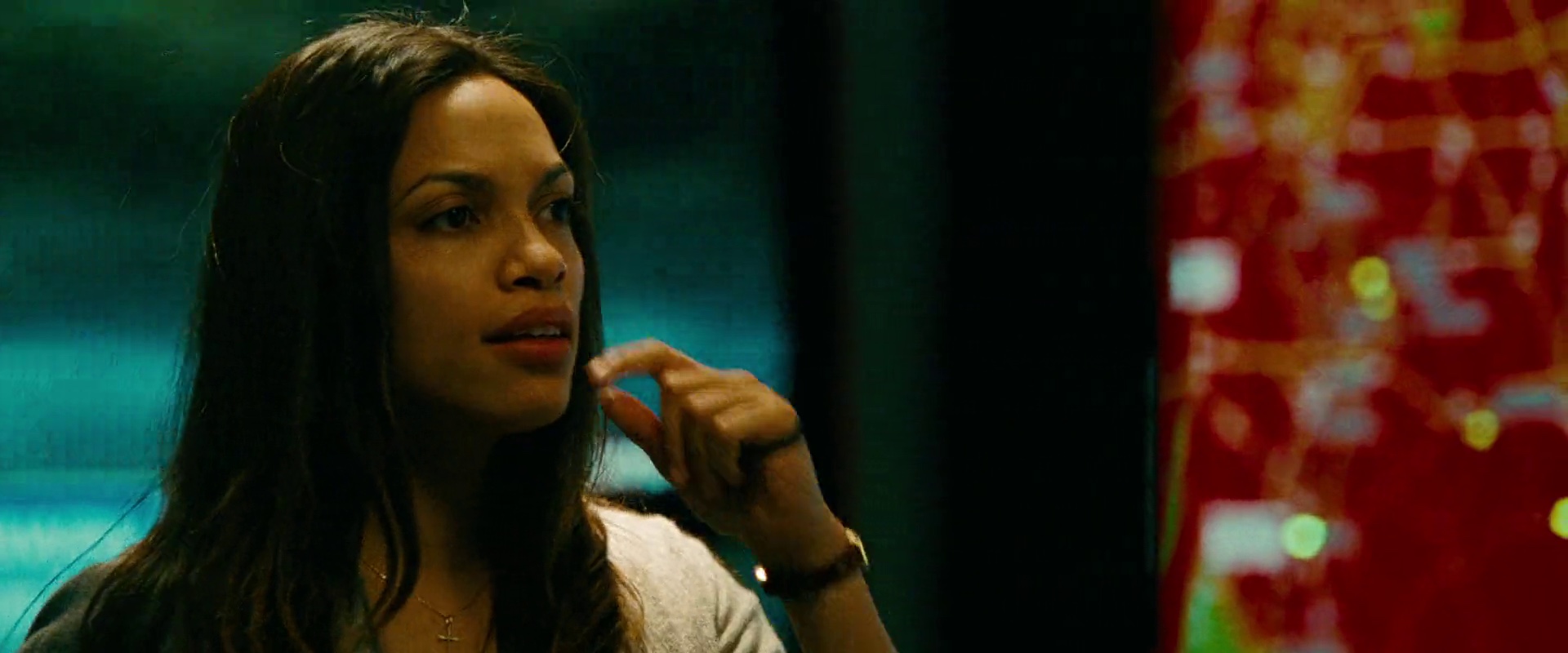
I hope you enjoy the movie visuals as much as I did.
I must confess that when I first saw “The American” in the movie theater last fall, I was completely blown away by the exquisite visual treatment that permeates every single frame. Set in rustic Italy, the camera follows George Clooney that plays a craftsman that constructs a custom weapon for the female assassin played by Thekla Reuten.
Daylight outdoors scenes combine pale verdant greens and light sky blues into a perfect backdrop that frames and keeps the focus on the main characters, while still placing them slightly off center to convey the open space around them:

Clooney’s character spends a lot of time driving between different towns, with the camera placement forgoing the usual just-inside-the-front-shield position. Instead, the shooting is done mostly from outside the car, with a couple of great reflection shots that combine character faces with the outside scenery:

One particularly attractive shot shows the car traveling in moonlight on a winding road, with the headlights piercing the eerie emerald fog creeping along the hill side:
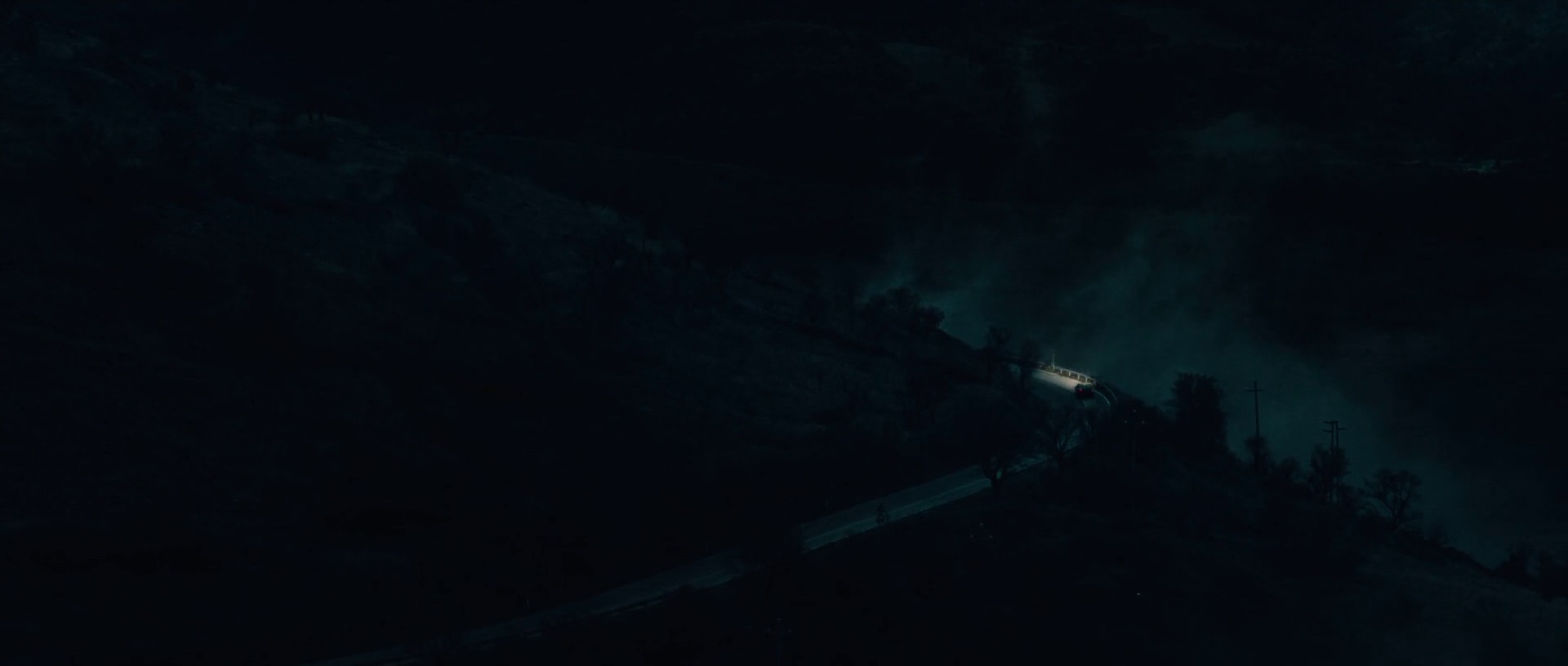
My favorite scene of the movie lasts less than a minute. Clooney goes to the train station to meet Reuten. The visual balance, colors and angle switches in this scene are simply fantastic. Here, the camera shoots from behind his left shoulder, keeping his blurred profile in frame and catching train’s reflection in the glass:

And this is shot from a slightly different angle, highlighting her confident pose and a deserted station:

I’m truly honored to have the cinematographer Martin Ruhe finding a few moments in his busy schedule to answer a few questions i had about his work on the movie and the industry in general.
Kirill: Tell us a little bit about yourself
Martin: I’m a german DP [director of photography] living in Berlin. I’ve done 6 films by now, hundreds of commercials and hundreds of music videos. That’s how i started with music videos 17 years ago. My first feature was a not a nice experience, so i waited a long time until Anton Corbijn asked me to do “Control” with him. I like the mixture of different projects and being able to wait for the right film to do by doing shorter projects. Plus it can be a good training in terms of gear, speed, working in different countries…

Corbijn and Ruhe on the set of “The American”
Kirill: Cinematography does not get as much limelight as directing, scripting, costume design or visual effects. Do you like working “behind the scenes”?
Martin: It’s OK because people who know and work in the industry understand what cinematographers do and appreciate it very much. Plus smaller films like “Control” get seen by a lot of people in the field, even though it’s not clear that they have an impact on the broad public. I was also lucky to get a lot of press attention on the cinematography on “The American”, “Harry Brown” and “Control”.
Kirill: How much creative freedom do you usually get, over specific scenes as well as the overall visual atmosphere of the movies you’re working on?
Martin: It’s always teamwork. I do not have to have a lot of freedom in how to do things. For me it has to come from within the story – what’s the right mood what does it feel like. It’s great to discover this together with the director. I am usually much involved and also like to mention things in the script if they do not make sense. In the past my directors trusted me a lot and it was a great collaboration. It’s nice to tell a story together.
Kirill: What is more frustrating, working with fickle weather conditions of unpredictable actors?
Martin: The weather i would think – there’s nothing you can do about it. On “The American” we started shooting in september in Abruzzo. We spent the first days of shooting in a village in the valley; it was like a very hot summer. When we finished in the mountains it was september and we had snow on some days. It was very tough also because all the trees had changed their color or lost their leaves, so maintaining the continuity was difficult. Here’s another example – Castel Del Monte lies 1600 meters above the sea level. You start shooting a scene in pure sunlight and then this cloud comes along and then you sit in it for hours (meaning in real heavy fog). What do you do? Do you start the scene again or wait or… The chase sequence and some other night scenes during that week are other example for bad weather. It was raining all night and at the end of the week the ground was freezing which was of course very tricky for cars chasing each other but also exhausting on crew and gear.

If an actor is unpredictable that’s OK. Most of the time, if it comes from within the story i think it’s cool because they can have a very different take on things. If it’s about insecurity then you have to earn their trust and protect them. For actors it can be difficult because unless they’re on set every day it might be hard for them to be fully part of it. There’s so much they don’t see happening and they don’t have a lot of say about things are done. Fortunately, the bigger stars i have been working with were trusting and relaxed about how we did things.
Kirill: Given the choice, would you prefer shooting as many takes as needed, or leave some of the visuals to the post-production phase?
Martin: Whatever you can do on set i think should be done there. But of course with post-production possibilities and schedules these days you always have to juggle and balance these things. On “The Countess” we used footage of Julie Delpy from a movie called “Homo Faber” from more than twenty years ago. We copied the lighting, tried to work out which lenses they used, Julie acted by a monitor to match the movement of the old scene and it worked. The effect was that in the final scene we tell how the countess gets married as a young woman, and we really see the young face of her. It was great because there’s also the way where you work and paint on the face in the post so you make a face of an actor of today younger. But it’s different – yes, there’s less wrinkles and all that but a face changes its shape so much and there’s more detail to it than a pure post solution can do. As far as i know we were the first ones to go this way.
Kirill: With advances in 3D shooting technology, we should expect this equipment to become available to even lower-budget productions in the next few years. Are you interested in exploring these new capabilities?
Martin: It’s OK. To be honest i have not seen a film yet where it has added that much to the story that i think it’s worth it. However, I am curious about the new Wenders movie about Pina Bausch and the art of her dance. But in general it seems to work well in animated films and not so much in the reality. It also seems to come from TV manufacturers trying to sell new products – rather than from movie goers missing anything. So it will be interesting whether that’s going to succeed. At the moment productions are very expensive, usually much longer and not too many of them have been that successful. Let’s see.
Kirill: The movie-going experience hasn’t changed much in the last few decades, with only incremental improvements in sound and picture quality. Do you foresee big changes in the decades to come?
Martin: Interesting question. I think the image on screen has gotten much better over the last decades, and the skills of crew are getting much better all over the place because also there’s so much more training available. And what about the 3D you mentioned in your question before? That’s a big change again, no?
But right now more and more films are produced on digital cameras. Having used them myself on commercials and two movies (“Harry Brown”, “Page Eight”) i can assure you that the best image quality is still on film. The new technology is getting better but the 35mm image is superior to all, yet it seems that more and more productions go digital. On films like “The Social Network” the decision is unlikely to have been about costs and there’s a lot of marketing going on for the new media; everybody seems to want to use the new technology but the decision is more and more not based on the cinematographers choice of what to use or on what’s the best quality. That seems weired to me.
Kirill: Among the movies you’ve worked on, what was your favorite location, and what would be the dream location if you were free to choose one?
Martin: There are so many beautiful places around so it’s hard to me to choose one… It probably would be in Italy! It’s such a beautiful country in every region. Definitely Abruzzo was the most beautiful location i visited for a film.
Kirill: At least in US, we’re constantly being bombarded by ads and trailers for big-budget movies. Can you recommend a few of your personal favorites that aren’t necessarily blockbusters?
Martin: “A Prophet” (french movie), “Let The Right One In” (swedish movie). I liked “Black Swan” and am very curious to see “Never Let Me Go“.
Kirill: Any exciting new projects that you’re working on?
Martin: I am reading some scripts but nothing is decided yet. I would love to do a movie in the states next. A good one.
And here i want to thank Martin once again for this great opportunity. Finally, if the train station sequence is my favorite one, then the night-time shots of the local coffee place are very close. Two dominant colors, golden brown and soft turquoise seems to spill into each other, with interior reflections superimposed on the street and wooden panels that match the color of the street lights. Also note how the two colors seem to “fight” over the skin tones of the actors:

Superb work by the costume designer Colleen Atwood and art directors Susanna Codognato and Marco Trentini.
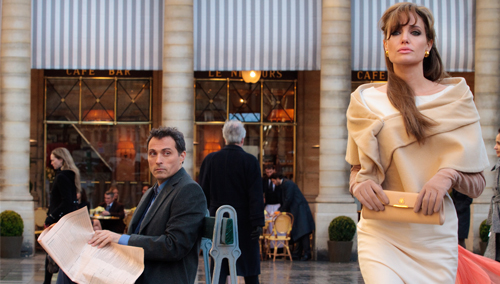
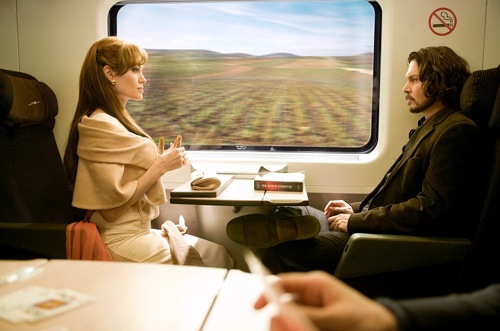
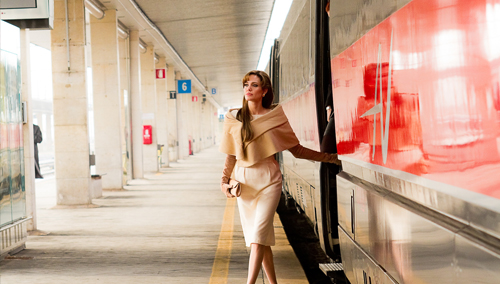
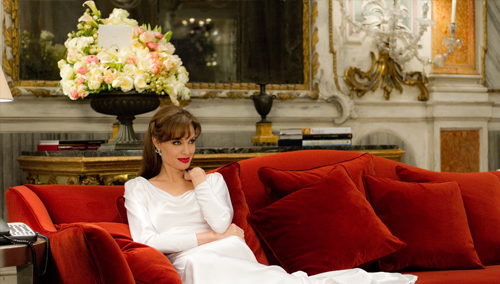
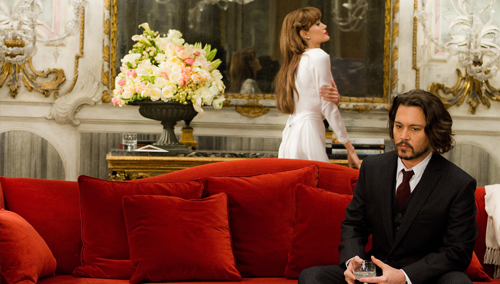

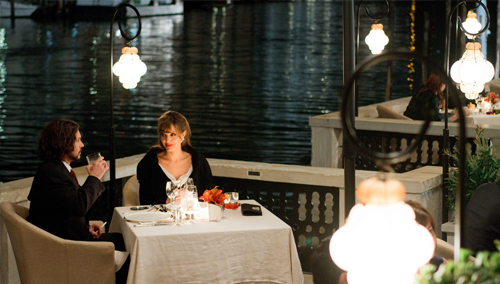
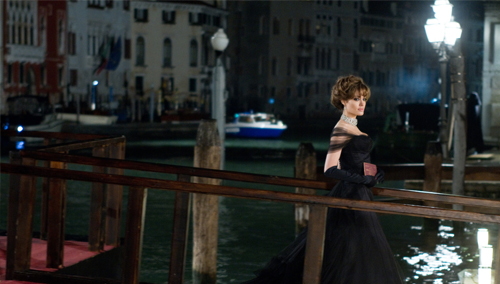
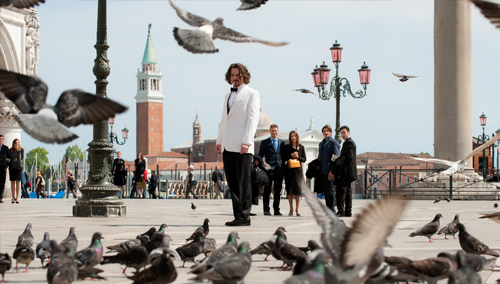
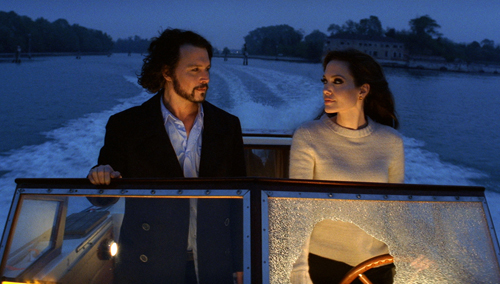

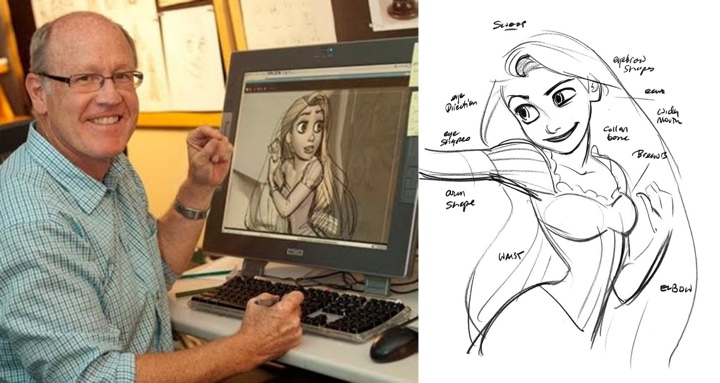
Glen Keane is one of the top Disney character animators, famous for his work on “The Little Mermaid”, “Pocahontas”, “Aladdin”, “Tarzan” and, most recently, for the remarkable Rapunzel in “Tangled”:
My sketch books and the figure drawings are the source for everything I’ve ever animated. It’s all these observations. The little things that make a huge difference. You don’t see it unless you are drawing it, and you have to draw it. In order to draw it, you have to have observed it. You can see it, or you can really see it.

Glen’s spartan sketches show how a trained artist needs just a few strokes to express genuine human emotions. The master sketches provide annotated guidance for character modelers, and animators, highlighting the connections between key anatomical features.
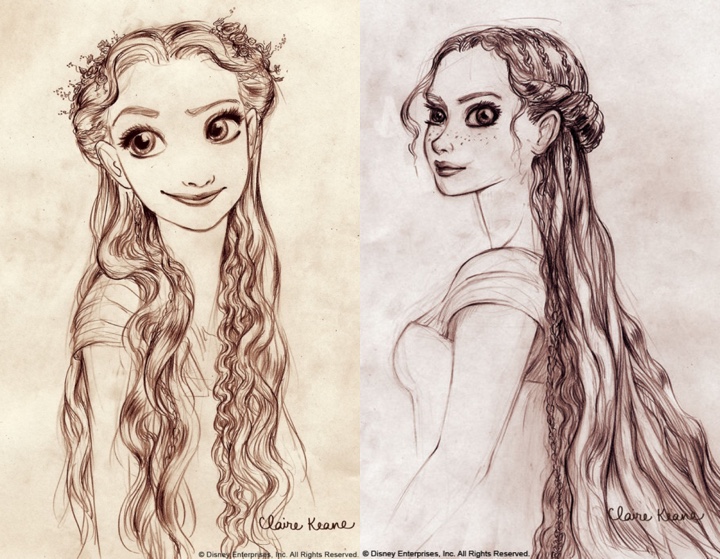
Further character development depends on the artistic vision of the movie directors, pushing the boundaries of computer graphics and material modeling. In this detailed sketch Claire Keane explores the intricacies of Rapunzel’s magic hair.
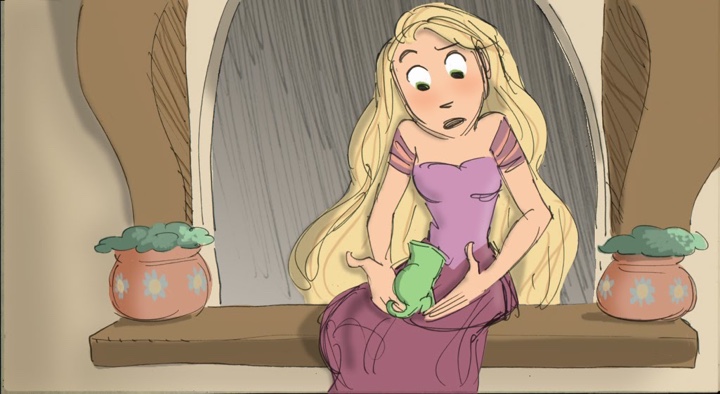
Storyboard artists work with the script to translate it into the key scene frames (which may happen even before the conceptual art exists). The story board is much less about character fidelity or fine facial expressions. It is about positioning the characters, defining camera angles, and high-level body expressions. A storyboard artist Mark Kennedy has posted a veritable treasure trove at his blog (part 1, part 2, part 3):
As a storyboard artist you want to get as many things right as you can: nail down the characters and their relationships and their personalities, of course, as well as all the story events, but also the staging, the layout and the look of everything as best you can. The more you can give the departments that come after you, the less time they have to spend inventing things out of thin air and the more time they can spend adding those great layers to what we’ve given them and turn our initial thoughts into the beautiful and nuanced end product.
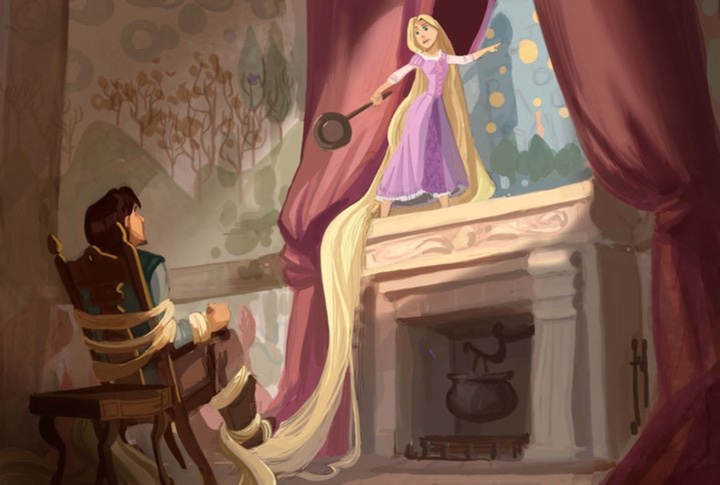
The story boards and the conceptual character art are then taken by the visual development artists. The mood, the tension and all the script intricacies of the specific scene come alive with scenery, inanimate objects, textures, colors and ambient lighting.
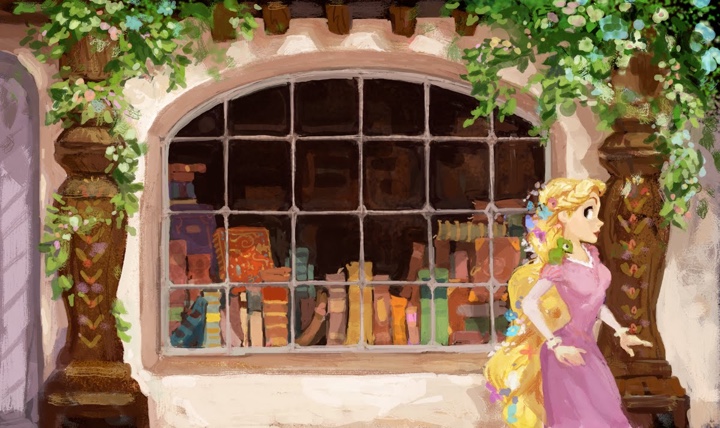
The bookshop scene did not make the final cut, but this artwork by Scott Watanabe is a perfect specimen of translating the festive mood of Rapunzel finally realizing her lifelong dream. Bright sunshine, colorful flowers in her hair and lush verdant vines sprawling down the wooden columns frame the veritable color bonanza of book display in the wide front store window. Aquamarines, oranges, yellows, purples and browns are masterfully arranged to create an inviting, yet not overwhelming backdrop to the “best day ever”.
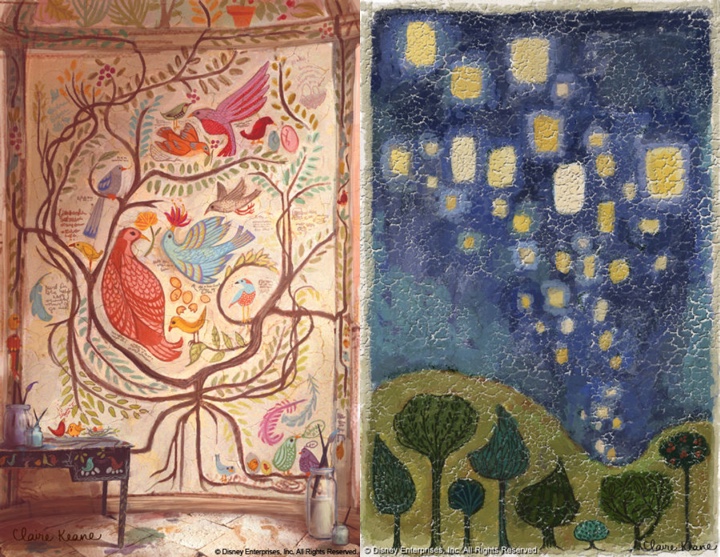
Mural artwork by Claire Keane highlights Rapunzel’s desire to explore the outside world.
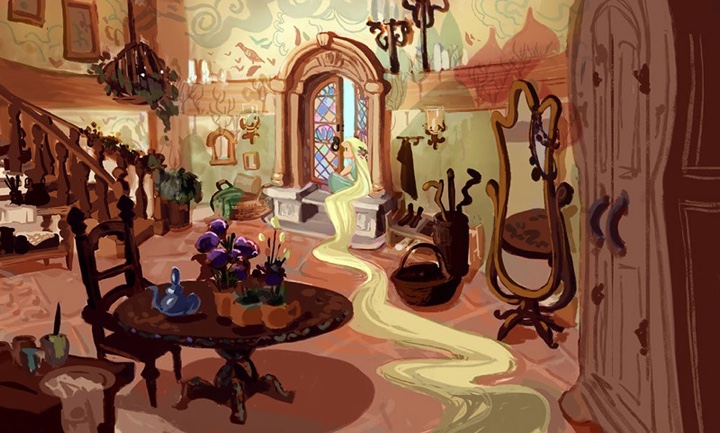
This artwork by Victoria Ying places Rapunzel in a richly decorated chamber filled with exquisite furniture. Note how every single detail supports her wish to go outside – the scene is dominated by the oversized dresser and dark mahogany table, with Rapunzel curling by the open window seemingly oblivious to the beautiful objects surrounding her.
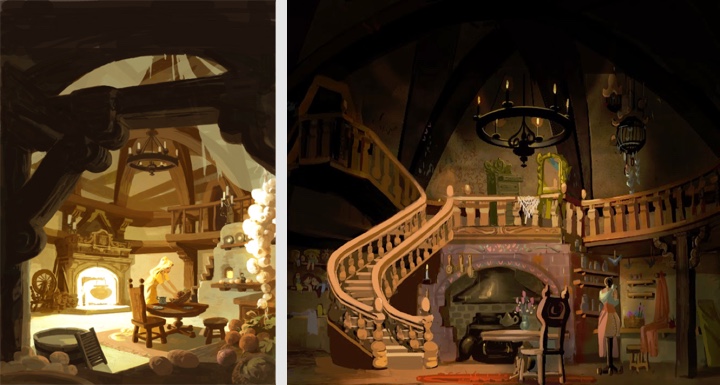
The artwork by Kevin Nelson and Victoria Ying contrasts the gloomy dome of the high-vaulted chamber with the bright blue sky outside.
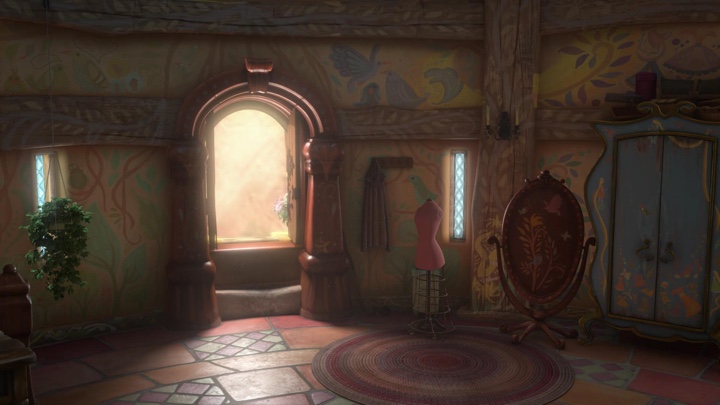
Conceptual art, refined sketches, storyboards, visual art – all of these are fed to the animators to create the final renders. The movie still combines the soothing pastel murals and the sun light streaming through the open window. Note the fine texture details of the wooden arc and the ambient shadows on the floor and the dress mannequin.
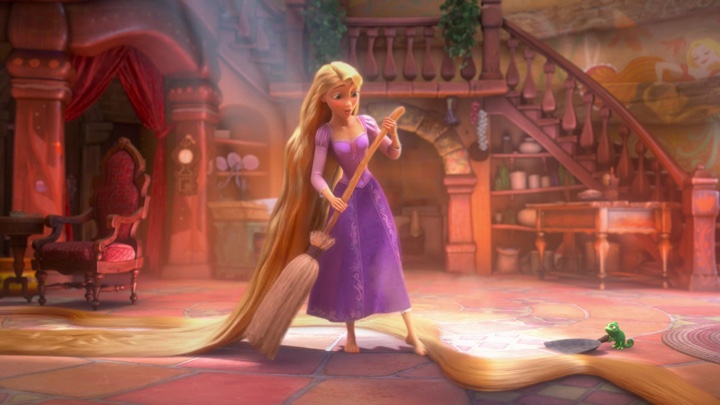
The streaming light in this scene highlights Rapunzel’s hair, casting a strong shadow around her. Note how the light diffuses throughout the entire chamber, bringing out the fine details of the armchair and the small table by the staircase base.
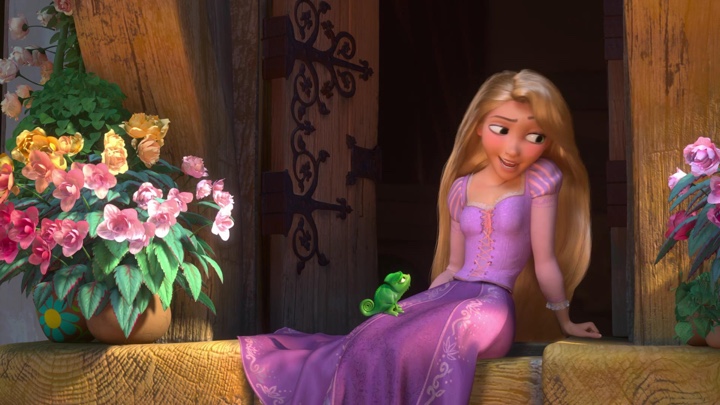
And this is the final render of one of the storyboard sketches seen earlier. The emotions in her face, the relaxed position of the shoulders, the intricate textures of the wooden beams and soft pastel flowers – all the painstaking artist work combined and rendered in a single frame. Mark Kennedy continues:
On “Tangled”, the directors (Nathan Greno and Byron Howard) were always very careful not to tell us board artists what we could and couldn’t do in the CG world. They always said to us, “just board it the best possible way you can, and we’ll figure out a way to make it happen”. And that’s just what we did. The technical people on “Tangled” were amazing and did an awesome job of accomplishing every insane idea we threw at them. I have no idea how they did it but they are spectacular!
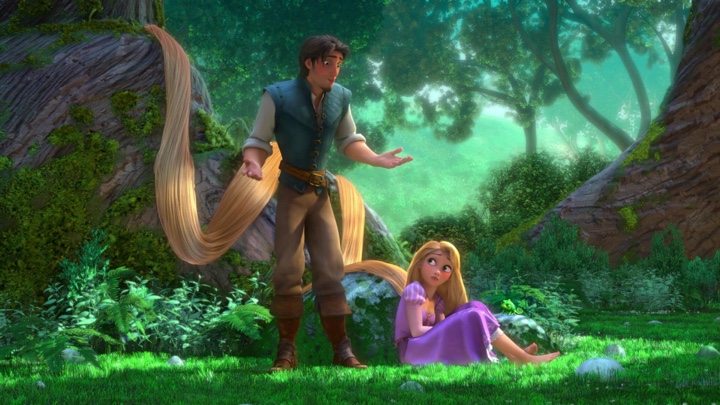
And you thought that “Sleeping Beauty” had a lush forest scenery… Rapunzel’s wish finally comes true, and she escapes the tower to visit the city. The entire scene is simply stunning – you can see every grass blade, every fern leaf and every moss lump. The sun light is partially blocked by the overhanging tree tops, and this allows the animators to bring out the full gamut of greens.

Managing to rival the beauty of the forest scene, the floating lanterns by the lake is by far the most memorable moment of the movie. Soft pinks, yellows and oranges of the lights highlighting the braided hair, dark purple sky highlighting the pastel purple dress, and dark brown wood of the boat serving as a visual anchor throughout the scene – simply amazing.
The art of “Tangled” supports the story – and not the other way around, as witnessed in way too many other animated movies released in the last few years. In the words of Mark Kennedy:
[…] when people ask me why it takes so long for us to get it “right” in story, and why story takes so long when our drawings don’t look like we spend much time on them, it’s because we spend a lot of our time debating these types of things, arguing with each other and working out the best way to tell the story and the best way to develop the characters. And when we do draw, it’s to try out these things and see how they work, and experiment and find the right way to tell the story and how to create the types of characters that people will fall in love with, root for and remember long after they’ve left the theater.
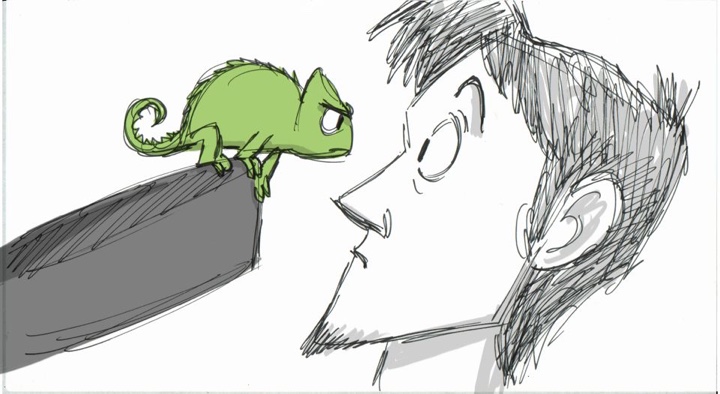

Images and video stills by Walt Disney Pictures.
Sources: apple.com · disney.wikia.com · amazon.com · parkablogs.com · artofdisney.canalblog.com · denofgeek.com · collider.com · blueman.ws · pavementmouse.blogspot.com · sevencamels.blogspot.com · victoriaying.blogspot.com · davidgilson.blogspot.com · theartofglenkeane.com · artofkevinnelson.blogspot.com
![]()
![]()
![]()
![]()
![]()
![]()
![]()
![]()
![]()
![]()
![]()
![]()
![]() Kirill: Tell us a little bit about yourself.
Kirill: Tell us a little bit about yourself.![]()
![]()
![]()
![]()